seats MERCEDES-BENZ E320 WAGON 2003 S210 Owner's Guide
[x] Cancel search | Manufacturer: MERCEDES-BENZ, Model Year: 2003, Model line: E320 WAGON, Model: MERCEDES-BENZ E320 WAGON 2003 S210Pages: 354, PDF Size: 13.99 MB
Page 68 of 354
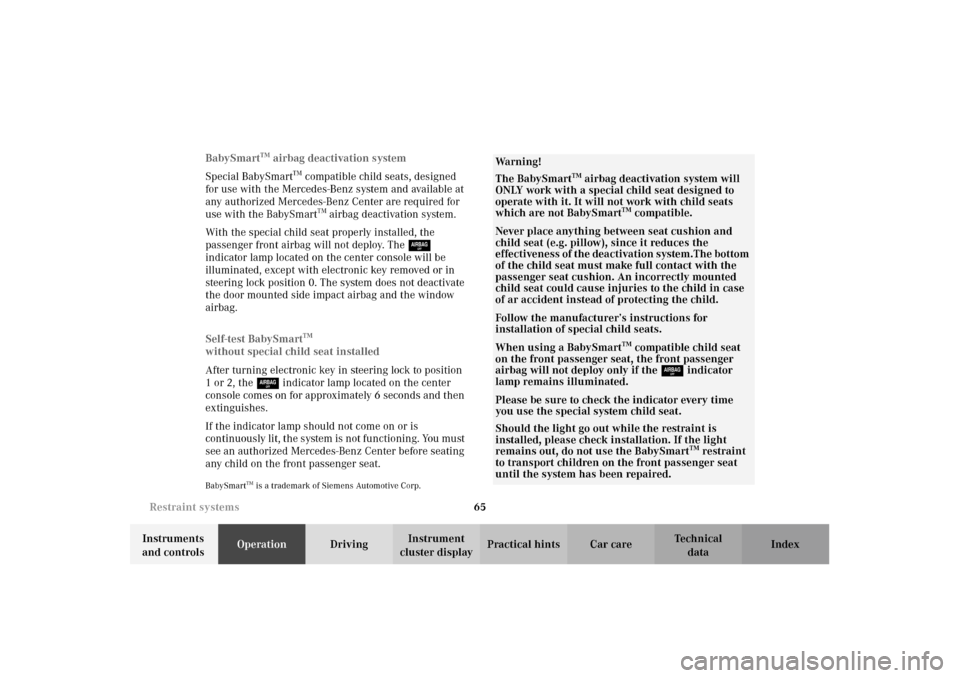
65 Restraint systems
Te ch n i c a l
data Instruments
and controlsOperationDrivingInstrument
cluster displayPractical hints Car care Index BabySmart
TM airbag deactivation system
Special BabySmart
TM compatible child seats, designed
for use with the Mercedes-Benz system and available at
any authorized Mercedes-Benz Center are required for
use with the BabySmart
TM airbag deactivation system.
With the special child seat properly installed, the
passenger front airbag will not deploy. The 7
indicator lamp located on the center console will be
illuminated, except with electronic key removed or in
steering lock position 0. The system does not deactivate
the door mounted side impact airbag and the window
airbag.
Self-test BabySmart
TM
without special child seat installed
After turning electronic key in steering lock to position
1 or 2, the 7 indicator lamp located on the center
console comes on for approximately 6 seconds and then
extinguishes.
If the indicator lamp should not come on or is
continuously lit, the system is not functioning. You must
see an authorized Mercedes-Benz Center before seating
any child on the front passenger seat.BabySmart
TM is a trademark of Siemens Automotive Corp.
Wa r n i n g !
The BabySmart
TM airbag deactivation system will
ONLY work with a special child seat designed to
operate with it. It will not work with child seats
which are not BabySmart
TM compatible.
Never place anything between seat cushion and
child seat (e.g. pillow), since it reduces the
effectiveness of the deactivation system.The bottom
of the child seat must make full contact with the
passenger seat cushion. An incorrectly mounted
child seat could cause injuries to the child in case
of ar accident instead of protecting the child.Follow the manufacturer’s instructions for
installation of special child seats.When using a BabySmart
TM compatible child seat
on the front passenger seat, the front passenger
airbag will not deploy only if the 7 indicator
lamp remains illuminated.
Please be sure to check the indicator every time
you use the special system child seat.
Should the light go out while the restraint is
installed, please check installation. If the light
remains out, do not use the BabySmart
TM restraint
to transport children on the front passenger seat
until the system has been repaired.
Page 69 of 354
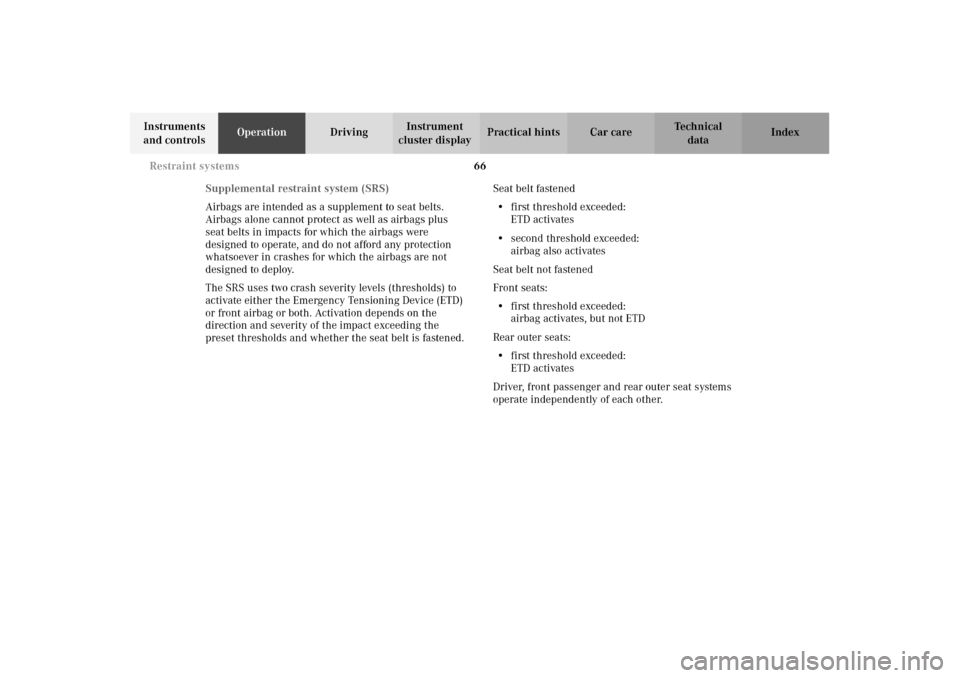
66 Restraint systems
Te ch n i c a l
data Instruments
and controlsOperationDrivingInstrument
cluster displayPractical hints Car care Index
Supplemental restraint system (SRS)
Airbags are intended as a supplement to seat belts.
Airbags alone cannot protect as well as airbags plus
seat belts in impacts for which the airbags were
designed to operate, and do not afford any protection
whatsoever in crashes for which the airbags are not
designed to deploy.
The SRS uses two crash severity levels (thresholds) to
activate either the Emergency Tensioning Device (ETD)
or front airbag or both. Activation depends on the
direction and severity of the impact exceeding the
preset thresholds and whether the seat belt is fastened.Seat belt fastened
•first threshold exceeded:
ETD activates
•second threshold exceeded:
airbag also activates
Seat belt not fastened
Front seats:
•first threshold exceeded:
airbag activates, but not ETD
Rear outer seats:
•first threshold exceeded:
ETD activates
Driver, front passenger and rear outer seat systems
operate independently of each other.
Page 70 of 354
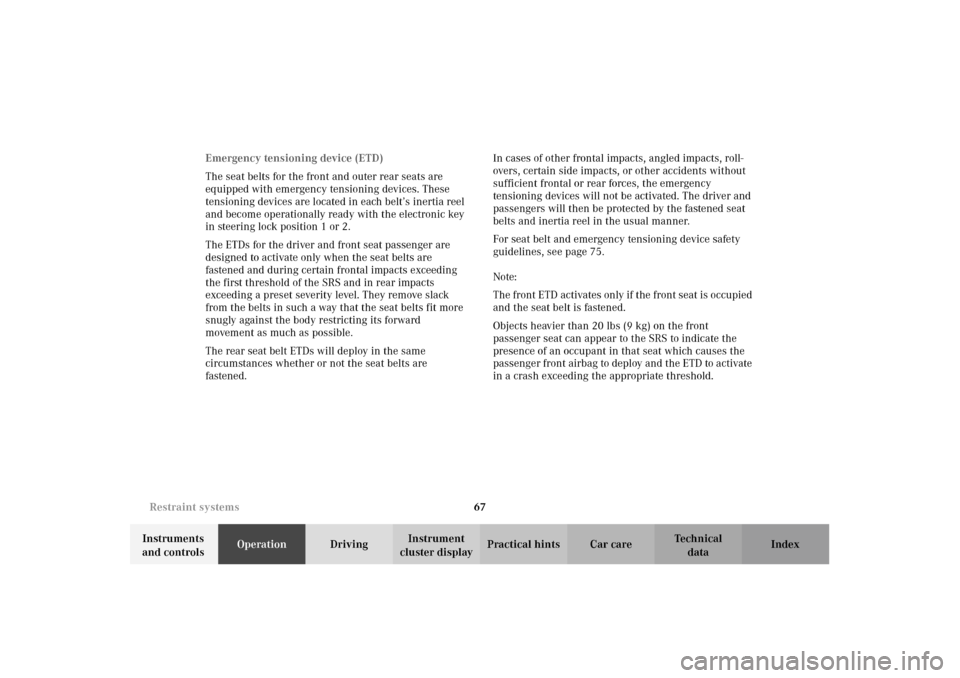
67 Restraint systems
Te ch n i c a l
data Instruments
and controlsOperationDrivingInstrument
cluster displayPractical hints Car care Index Emergency tensioning device (ETD)
The seat belts for the front and outer rear seats are
equipped with emergency tensioning devices. These
tensioning devices are located in each belt’s inertia reel
and become operationally ready with the electronic key
in steering lock position 1 or 2.
The ETDs for the driver and front seat passenger are
designed to activate only when the seat belts are
fastened and during certain frontal impacts exceeding
the first threshold of the SRS and in rear impacts
exceeding a preset severity level. They remove slack
from the belts in such a way that the seat belts fit more
snugly against the body restricting its forward
movement as much as possible.
The rear seat belt ETDs will deploy in the same
circumstances whether or not the seat belts are
fastened.In cases of other frontal impacts, angled impacts, roll-
overs, certain side impacts, or other accidents without
sufficient frontal or rear forces, the emergency
tensioning devices will not be activated. The driver and
passengers will then be protected by the fastened seat
belts and inertia reel in the usual manner.
For seat belt and emergency tensioning device safety
guidelines, see page 75.
Note:
The front ETD activates only if the front seat is occupied
and the seat belt is fastened.
Objects heavier than 20 lbs (9 kg) on the front
passenger seat can appear to the SRS to indicate the
presence of an occupant in that seat which causes the
passenger front airbag to deploy and the ETD to activate
in a crash exceeding the appropriate threshold.
Page 80 of 354
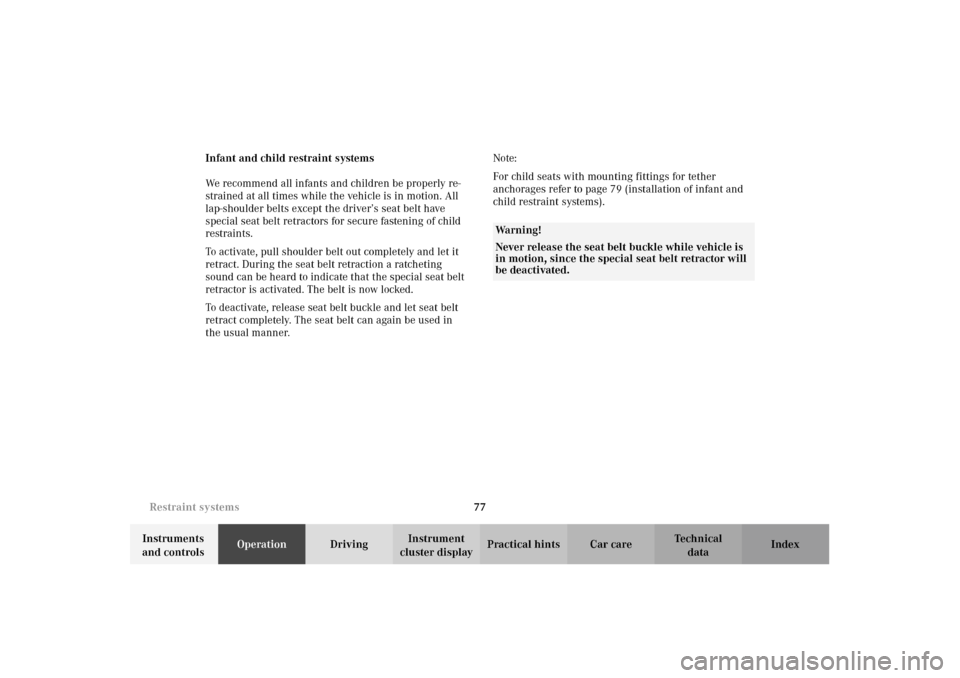
77 Restraint systems
Te ch n i c a l
data Instruments
and controlsOperationDrivingInstrument
cluster displayPractical hints Car care Index Infant and child restraint systems
We recommend all infants and children be properly re-
strained at all times while the vehicle is in motion. All
lap-shoulder belts except the driver’s seat belt have
special seat belt retractors for secure fastening of child
restraints.
To activate, pull shoulder belt out completely and let it
retract. During the seat belt retraction a ratcheting
sound can be heard to indicate that the special seat belt
retractor is activated. The belt is now locked.
To deactivate, release seat belt buckle and let seat belt
retract completely. The seat belt can again be used in
the usual manner.Note:
For child seats with mounting fittings for tether
anchorages refer to page 79 (installation of infant and
child restraint systems).
Wa r n i n g !
Never release the seat belt buckle while vehicle is
in motion, since the special seat belt retractor will
be deactivated.
Page 81 of 354
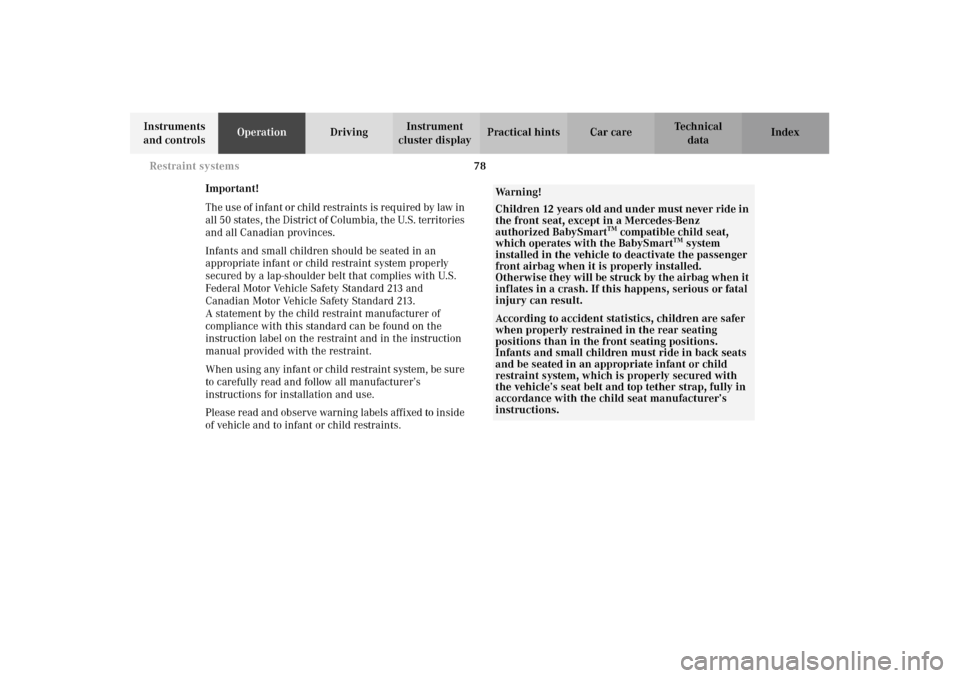
78 Restraint systems
Te ch n i c a l
data Instruments
and controlsOperationDrivingInstrument
cluster displayPractical hints Car care Index
Important!
The use of infant or child restraints is required by law in
all 50 states, the District of Columbia, the U.S. territories
and all Canadian provinces.
Infants and small children should be seated in an
appropriate infant or child restraint system properly
secured by a lap-shoulder belt that complies with U.S.
Federal Motor Vehicle Safety Standard 213 and
Canadian Motor Vehicle Safety Standard 213.
A statement by the child restraint manufacturer of
compliance with this standard can be found on the
instruction label on the restraint and in the instruction
manual provided with the restraint.
When using any infant or child restraint system, be sure
to carefully read and follow all manufacturer’s
instructions for installation and use.
Please read and observe warning labels affixed to inside
of vehicle and to infant or child restraints.
Wa r n i n g !
Children 12 years old and under must never ride in
the front seat, except in a Mercedes-Benz
authorized BabySmart
TM compatible child seat,
which operates with the BabySmart
TM system
installed in the vehicle to deactivate the passenger
front airbag when it is properly installed.
Otherwise they will be struck by the airbag when it
inflates in a crash. If this happens, serious or fatal
injury can result.
According to accident statistics, children are safer
when properly restrained in the rear seating
positions than in the front seating positions.
Infants and small children must ride in back seats
and be seated in an appropriate infant or child
restraint system, which is properly secured with
the vehicle’s seat belt and top tether strap, fully in
accordance with the child seat manufacturer’s
instructions.
Page 82 of 354
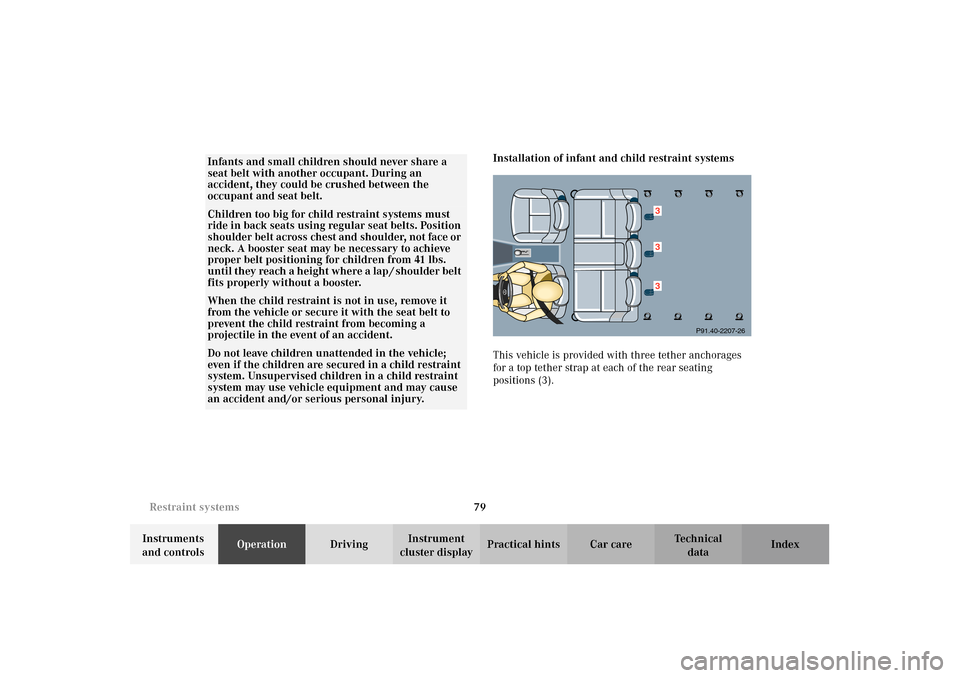
79 Restraint systems
Te ch n i c a l
data Instruments
and controlsOperationDrivingInstrument
cluster displayPractical hints Car care Index
a
Installation of infant and child restraint systems
This vehicle is provided with three tether anchorages
for a top tether strap at each of the rear seating
positions (3).
Infants and small children should never share a
seat belt with another occupant. During an
accident, they could be crushed between the
occupant and seat belt.Children too big for child restraint systems must
ride in back seats using regular seat belts. Position
shoulder belt across chest and shoulder, not face or
neck. A booster seat may be necessary to achieve
proper belt positioning for children from 41 lbs.
until they reach a height where a lap / shoulder belt
fits properly without a booster.When the child restraint is not in use, remove it
from the vehicle or secure it with the seat belt to
prevent the child restraint from becoming a
projectile in the event of an accident.Do not leave children unattended in the vehicle;
even if the children are secured in a child restraint
system. Unsupervised children in a child restraint
system may use vehicle equipment and may cause
an accident and/or serious personal injury.
P91.40-2207-26
333
Page 204 of 354
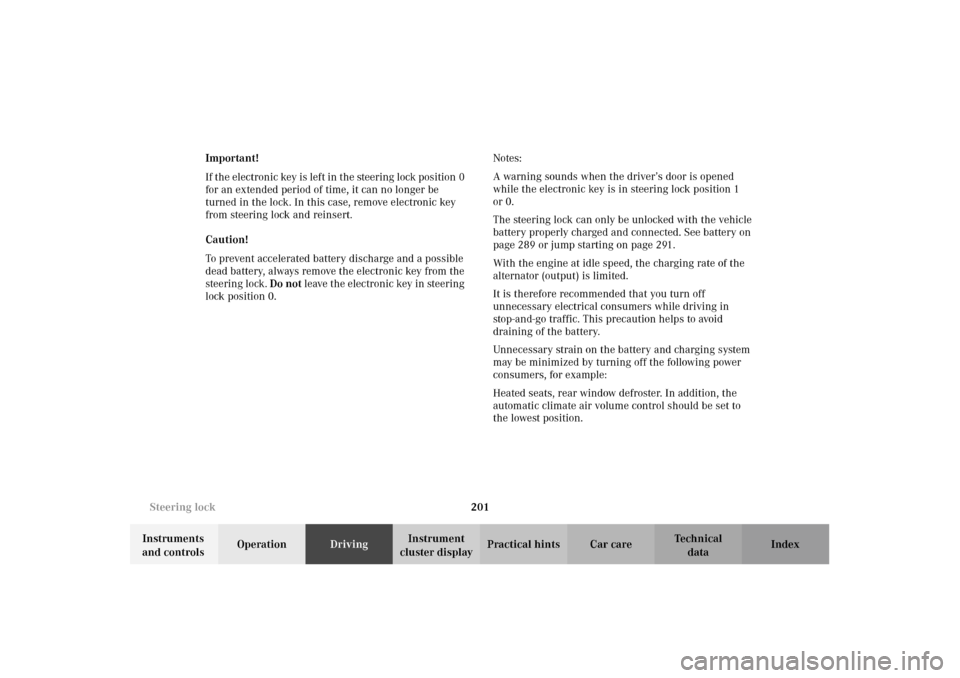
201 Steering lock
Te ch n i c a l
data Instruments
and controlsOperationDrivingInstrument
cluster displayPractical hints Car care Index Important!
If the electronic key is left in the steering lock position 0
for an extended period of time, it can no longer be
turned in the lock. In this case, remove electronic key
from steering lock and reinsert.
Caution!
To prevent accelerated battery discharge and a possible
dead battery, always remove the electronic key from the
steering lock. Do not leave the electronic key in steering
lock position 0.Notes:
A warning sounds when the driver’s door is opened
while the electronic key is in steering lock position 1
or 0.
The steering lock can only be unlocked with the vehicle
battery properly charged and connected. See battery on
page 289 or jump starting on page 291.
With the engine at idle speed, the charging rate of the
alternator (output) is limited.
It is therefore recommended that you turn off
unnecessary electrical consumers while driving in
stop-and-go traffic. This precaution helps to avoid
draining of the battery.
Unnecessary strain on the battery and charging system
may be minimized by turning off the following power
consumers, for example:
Heated seats, rear window defroster. In addition, the
automatic climate air volume control should be set to
the lowest position.
Page 252 of 354
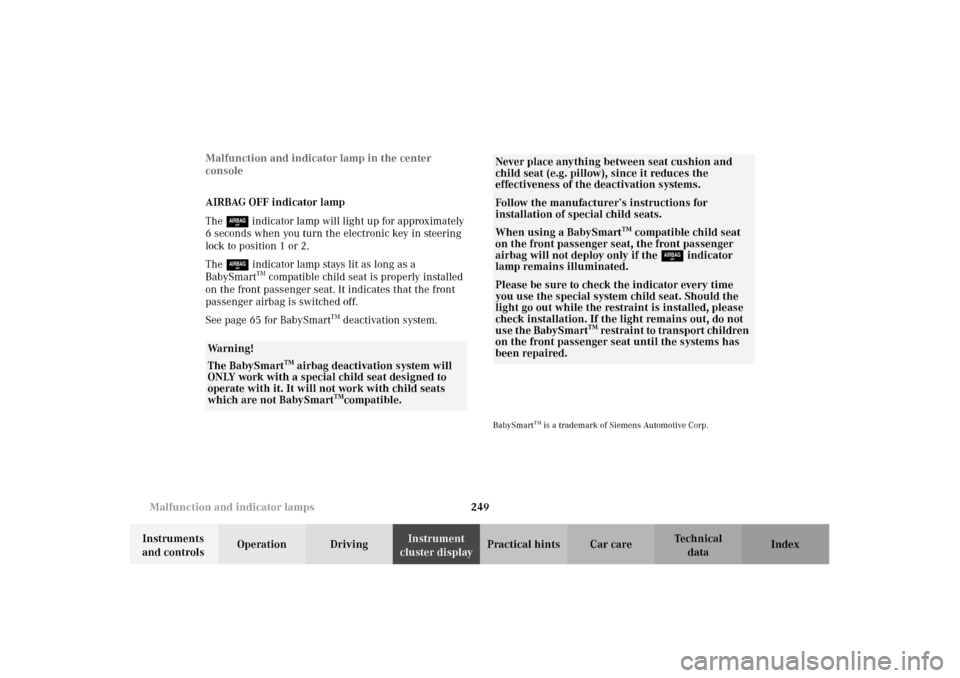
249 Malfunction and indicator lamps
Te ch n i c a l
data Instruments
and controlsOperation DrivingInstrument
cluster displayPractical hints Car care Index Malfunction and indicator lamp in the center
console
AIRBAG OFF indicator lamp
The 7 indicator lamp will light up for approximately
6 seconds when you turn the electronic key in steering
lock to position 1 or 2.
The 7 indicator lamp stays lit as long as a
BabySmart
TM compatible child seat is properly installed
on the front passenger seat. It indicates that the front
passenger airbag is switched off.
See page 65 for BabySmart
TM deactivation system.
BabySmart
TM is a trademark of Siemens Automotive Corp.
Wa r n i n g !
The BabySmart
TM airbag deactivation system will
ONLY work with a special child seat designed to
operate with it. It will not work with child seats
which are not BabySmart
TMcompatible.
Never place anything between seat cushion and
child seat (e.g. pillow), since it reduces the
effectiveness of the deactivation systems.Follow the manufacturer’s instructions for
installation of special child seats.When using a BabySmart
TM compatible child seat
on the front passenger seat, the front passenger
airbag will not deploy only if the 7 indicator
lamp remains illuminated.
Please be sure to check the indicator every time
you use the special system child seat. Should the
light go out while the restraint is installed, please
check installation. If the light remains out, do not
use the BabySmart
TM restraint to transport children
on the front passenger seat until the systems has
been repaired.
Page 322 of 354
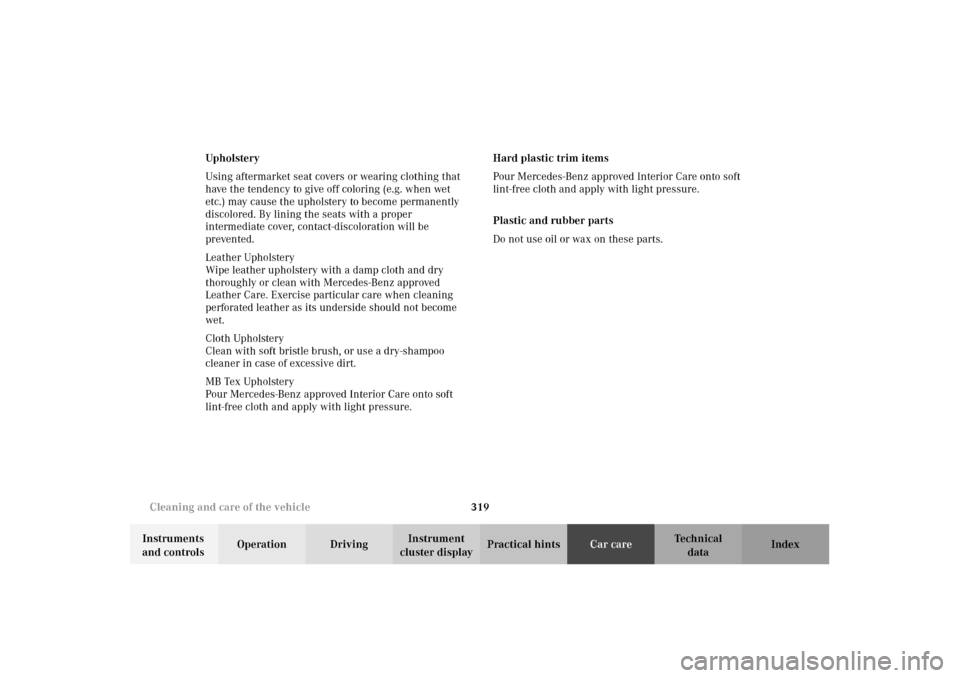
319 Cleaning and care of the vehicle
Te ch n i c a l
data Instruments
and controlsOperation DrivingInstrument
cluster displayPractical hintsCar careIndex Upholstery
Using aftermarket seat covers or wearing clothing that
have the tendency to give off coloring (e.g. when wet
etc.) may cause the upholstery to become permanently
discolored. By lining the seats with a proper
intermediate cover, contact-discoloration will be
prevented.
Leather Upholstery
Wipe leather upholstery with a damp cloth and dry
thoroughly or clean with Mercedes-Benz approved
Leather Care. Exercise particular care when cleaning
perforated leather as its underside should not become
wet.
Cloth Upholstery
Clean with soft bristle brush, or use a dry-shampoo
cleaner in case of excessive dirt.
MB Tex Upholstery
Pour Mercedes-Benz approved Interior Care onto soft
lint-free cloth and apply with light pressure.Hard plastic trim items
Pour Mercedes-Benz approved Interior Care onto soft
lint-free cloth and apply with light pressure.
Plastic and rubber parts
Do not use oil or wax on these parts.
Page 344 of 354
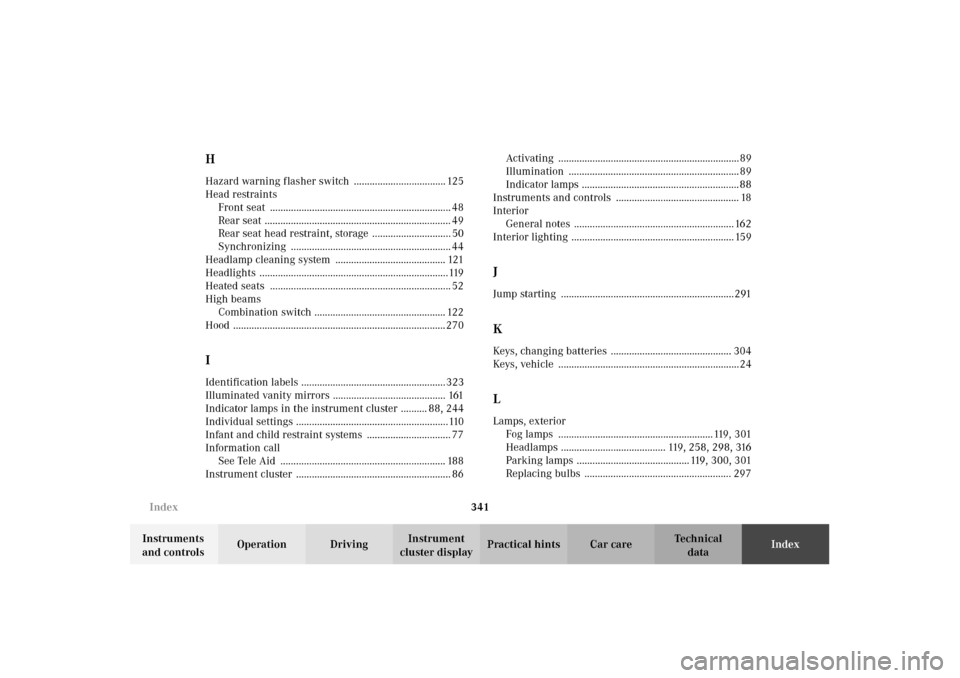
341 Index
Te ch n i c a l
data Instruments
and controlsOperation DrivingInstrument
cluster displayPractical hints Car careIndex
HHazard warning flasher switch ................................... 125
Head restraints
Front seat ..................................................................... 48
Rear seat ....................................................................... 49
Rear seat head restraint, storage .............................. 50
Synchronizing ............................................................. 44
Headlamp cleaning system .......................................... 121
Headlights ........................................................................119
Heated seats ..................................................................... 52
High beams
Combination switch .................................................. 122
Hood ................................................................................. 270IIdentification labels ....................................................... 323
Illuminated vanity mirrors ........................................... 161
Indicator lamps in the instrument cluster .......... 88, 244
Individual settings ..........................................................110
Infant and child restraint systems ................................ 77
Information call
See Tele Aid ............................................................... 188
Instrument cluster ........................................................... 86Activating .....................................................................89
Illumination ................................................................. 89
Indicator lamps ............................................................ 88
Instruments and controls ............................................... 18
Interior
General notes ............................................................. 162
Interior lighting .............................................................. 159
JJump starting ..................................................................291KKeys, changing batteries .............................................. 304
Keys, vehicle .....................................................................24LLamps, exterior
Fog lamps ........................................................... 119, 301
Headlamps ........................................ 119, 258, 298, 316
Parking lamps ........................................... 119, 300, 301
Replacing bulbs ........................................................ 297